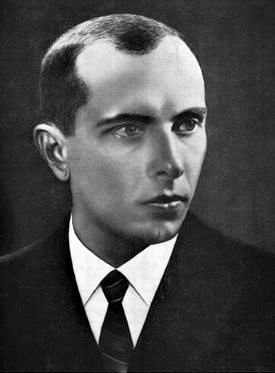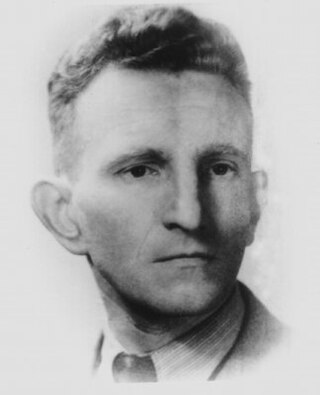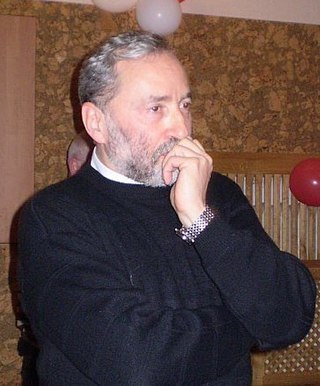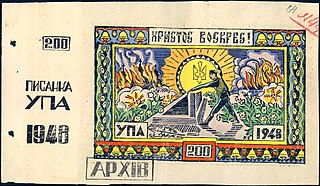
The massacres of Poles in Volhynia and Eastern Galicia were carried out in German-occupied Poland by the Ukrainian Insurgent Army (UPA) with the support of parts of the local Ukrainian population against the Polish minority in Volhynia, Eastern Galicia, parts of Polesia and Lublin region from 1943 to 1945. The peak of the massacres took place in July and August 1943. The massacres were exceptionally brutal and affected primarily women and children. The UPA's actions resulted in about 50,000 to 100,000 deaths. Other victims of the massacres included several hundred Jews, Russians, Czechs, Georgians, and Ukrainians who were part of Polish families or opposed the UPA and sabotaged the massacres by hiding Polish escapees.

Stepan Andriyovych Bandera was a Ukrainian far-right leader of the radical, militant wing of the Organization of Ukrainian Nationalists, the OUN-B.

The Ukrainian Insurgent Army was a Ukrainian nationalist paramilitary and partisan formation founded by the Organization of Ukrainian Nationalists on October 14, 1942. During World War II, it was engaged in guerrilla warfare against the Soviet Union, the Polish Underground State, Communist Poland, and Nazi Germany.
The Organisation of Ukrainian Nationalists was a Ukrainian nationalist organisation established in 1929 in Vienna, uniting the Ukrainian Military Organization with smaller, mainly youth, radical nationalist right-wing groups. The OUN was the largest and one of the most important far-right Ukrainian organizations operating in the interwar period on the territory of the Second Polish Republic.

Roman-Taras Yosypovych Shukhevych was a Ukrainian nationalist and a military leader of the Ukrainian Insurgent Army (UPA).

Yaakov Dov Bleich is an American-born rabbi. He serves as Rabbi of the Kyiv synagogue in Podil since 1989. Rabbi Bleich was vice-president of the World Jewish Congress from 2009-2017. Bleich chose not to run for re-election as a member of the WJC Executive Committee at the WJC’s May 2021 plenary assembly.

Yaroslav Semenovych Stetsko was a Ukrainian politician, writer and Nazi collaborator, who served as the leader of Stepan Bandera's faction of the Organization of Ukrainian Nationalists, the OUN-B, from 1968 until his death. During the German invasion of the Soviet Union in 1941, he was named the temporary head of a self-proclaimed independent Ukrainian government which was declared in the act of restoration of the Ukrainian state. Following the war, Stetsko was the head of the Anti-Bolshevik Bloc of Nations until his death in 1986.
Petro Voinovsky was a Ukrainian nationalist. He lived in Bukovina, served in the Romanian army in the rank of lieutenant, resigned in 1935 due to the policy of "Romanianization". He participated in Ukrainian scouting organization Plast, joined OUN in 1930s. Initially supported Stepan Bandera, but later moved to Andriy Melnyk's faction. Since 1940 Voinovsky was the regional leader of OUN in Bukovina and Bessarabia.

The Nachtigall Battalion, also known as the Ukrainian Nightingale Battalion Group, or officially as Special Group Nachtigall was a subunit under command of the German Abwehr special-operations unit Lehrregiment "Brandenburg" z.b.V. 800 in 1941. Along with the Roland Battalion it was one of two military units which originated on February 25, 1941, when the head of the Abwehr, Admiral Wilhelm Franz Canaris, sanctioned the formation of a "Ukrainian Legion" under German command. The Legion was composed of volunteer Ukrainians many of whom were members or supporters of Organization of Ukrainian Nationalists (OUN-B). The Batallion participated in early stages of Operation Barbarossa with Army Group South between June and August 1941.

Yosyf Samuyilovych Zisels, also Josef Zissels, is a Ukrainian human rights activist and former Soviet dissident.
Sluzhba Bezpeky or SB OUN, was the Ukrainian partisan underground intelligence service, and a division of the Organization of Ukrainian Nationalists responsible for clandestine operations and anti-espionage during World War II. In its short history, the SB committed acts of terror against civilians and non-civilians and their families, including people suspected either of collaborating, or serving with the Soviet forces in western Ukraine. In this capacity, the SB also played a significant role in the ethnic cleansing and killing of the Polish population in Volhynia and Galicia.
This article presents the historiography of the Volyn tragedy as presented by historians in Poland and Ukraine after World War II. The Massacres of Poles in Volhynia were part of the ethnic cleansing operation in the Polish province of Eastern Galicia and Volhynia that took place beginning in March 1943 and lasted until the end of 1944. According to political scientist Nathaniel Copsey, research into this event was quite partisan until 2009 and dominated by Polish researchers, some of whom lived there at the time or are descended from those who did. The most thorough is the work of Ewa and Władysław Siemaszko, the result of years of research conducted with the goal of demonstrating that the Poles were victims of genocide. Nonetheless, the 45 years of state censorship resulted in an excessive supply of works described as "heavy in narrative", "light in analysis" and "inherently - though perhaps unconsciously - biased against Ukrainians."
Ukrainian People's Militsiya or the Ukrainian National Militsiya, was a paramilitary formation created by the Organization of Ukrainian Nationalists (OUN) in the General Government territory of occupied Poland and later in the Reichskommissariat Ukraine during World War II. It was set up in the course of Operation Barbarossa, the 1941 invasion of the Soviet Union.

The Shot in the Back is monument in Simferopol, Crimea, funded by Crimean residents and the Communist Party of Ukraine (KPU) to commemorate Soviet citizens and Red Army soldiers who were killed by the Ukrainian Insurgent Army (UPA) members during and after World War II. Standing 3.5 meters high, the monument was installed on Sovetskaya square. It was unveiled on 14 September 2007.

Volodymyr Mykhailovych Viatrovych is a Ukrainian historian, civic activist and politician.
Arsen Klinchaev is a Ukrainian politician, member of the Party of Regions, veteran of the war at Nagorny-Karabakh. Klinchaev is a leader of the All-Ukrainian organization Youth Guard.

Bofons - one-sided monetary documents (receipts) issued by the right-wing Ukrainian nationalist organizations Organization of Ukrainian Nationalists (OUN) and Ukrainian Insurgent Army (UPA) in their insurgency against the Soviet Union during and after World War II. They carried national symbols and symbols of the OUN and UPA and corresponding inscriptions, with fixed denominations or without denominations. Authorized persons on behalf of the OUN or UPA issued them to the population for voluntarily contributed, collected as a contingent, requisitioned funds, in the form of cash, sometimes food, clothing, etc. In addition to their purely financial role, bofons also served an agitational function, so they were used in insurgent propaganda work.

The Stepan Bandera monument in Lviv is a statue dedicated to Stepan Bandera, a controversial twentieth century Ukrainian politician, in the city of Lviv, one of the main cities of Western Ukraine.

The Anti-Soviet resistance by the Ukrainian Insurgent Army, was a guerrilla war waged by Ukrainian nationalist partisan formations against the Soviet Union in the western regions of the Ukrainian SSR and southwestern regions of the Byelorussian SSR, during and after World War II.

There are numerous monuments to Stepan Bandera in different cities in Ukraine. Monuments to Bandera, a Ukrainian leader of a split faction of the Organisation of Ukrainian Nationalists leadership, have been erected in Galicia, Volyn and partially in Western Podillia, but there are projects to erect monuments to Bandera in cities of other regions in the west of the country, in particular in Lutsk and Khmelnytsky. Also, the question of erecting a monument or memorial sign in honor of Bandera in the capital of the state Kyiv was repeatedly raised, as well as in Chernivtsi. Over 40 monuments have been erected.













